David Bernstein
-
- Cruising Beyond Compliance Maritime Logistics Professional, Q1 2014 #16
The global cruise industry quietly takes a prime mover role in maritime scrubber technology. That’s just smart business.
A recent issue of Virtuoso Life, a glossy magazine aimed at upscale travelers, featured a short article highlighting Princess Cruises’ Royal Princess, christened by Duchess Kate Middleton in June, 2013. This article, along with numerous other reviews, highlighted the magnificent atrium, the spa, and the private cabanas. While Princess’s bona fides in shipping’s green camp are well known to shipping people (Princess was an early proponent of cold ironing as far back as 2000; hooking up to shore power at Pacific ports such as Juneau and Seattle), such developments are far removed from the general public – the industry’s customer base.
Two Kinds of Green
Cruise lines, with their voracious appetite for power – feeding both propulsion and hotel load – are also making tremendous, but quiet strides towards energy efficiency. At the same time, restrictions on the sulfur content of fuels are increasing the cost of operations for all manners of global maritime commerce. For example, owners trading within the North American Emission Control Area (ECA) saw a 1percent ceiling on sulfur content imposed in the summer of 2012. In 2015, vessels trading within the ECA will see that ceiling again dropped to 0.1%. Analysts anticipate that the cost differential of low sulfur marine fuel over the high sulfur grade (3.5% maximum since 2012) will increase. And, during December 2013 and January 2014, low sulfur “bunkers” (IFO 180) cost more ($50 to $70/ton) around the U.S. East Coast and, even more ($150 to $195/ton) at U.S. West Coast ports.
The advent of severe restrictions in the ECA’s, a profound business disruptor, has forced the cruise industry to take action. Consider that Carnival Corporation made the news in September 2013, when it announced that it would be spending a reported $180 million on development, partnering with a so far un-named vendor, on a space-saving combination scrubber/particulate filter. Initially, the technology would be deployed on up to 32 vessels trading mainly around North America, including those in Princess and Holland America brands, besides its eponymous Carnival Cruise Line.
Business Models that Make Sense
The Cruise Lines International Association (CLIA) said, in a 2013 position paper: “A one-size-fits-all approach that exclusively requires the use of low sulfur fuel throughout the 200-mile ECA is not the most effective or efficient compliance option allowed under the regulations.” In the cruise industry, therefore, a more creative solution is emerging.
Roger Frizzell, Carnival Corporation’s Chief Communications Officer, told MarPro in February, “We are tremendously excited about the progress we are making with our new and innovative scrubber technology.” Mr. Frizzell also pointed to plans for Carnival’s European brands, adding , “… we are also looking to expand this breakthrough technology to our other brands that are based outside the United States,” mentioning Aida and Costa. He also noted, “Aida, for instance, is one of the early adopters of the scrubbers, with plans to install the technology across its fleet.” Aida, where shorter voyages mean more port time, had announced a €100 million investment program in the summer of 2013. That technology was described as a new, comprehensive filter system that would be deployed on existing and newbuild vessels.
Slimming Bunker Buys with a Heavy Helping of Technology
For 2014, Carnival estimates its overall fuel spending to be a staggering $2.1 billion, based on 3.2 million metric tonnes at an average price of $650/tonne. In regulatory filings from 2013, Carnival had estimated that extra fuel costs, because of ECA’s, would be $265 million in 2015. From the perspective of payback on its scrubber investment, Carnival’s Chief Financial Officer, Mr. David Bernstein, said, on Carnival’s latest investor call, “At this point, it’s fair to say that more than the majority of that $265 million will disappear, so the number will be less than half.” These economics are impressive by any criterion: annual benefits of as much as $130 million on an investment of around $180 million. Moreover, Carnival claims in its latest 10K filing (tied to its 2013 Annual Report), “As a result of installing these scrubbers, we believe the cost of complying with the 2015 ECA sulfur emission requirement will not be significant to our results of operations.” Published reports suggest that Carnival has gained an extra year, to 2016, to achieve implementation. During port calls, the vessels will switch over to shore power, or burn low sulfur fuel. Particulates, trapped in a filter, will be disposed of in port.
Bud Darr, CLIA’s Senior Vice President of Technical and Regulatory Affairs, spoke at length with Maritime Professional about the cruise industry’s proactive and forward-thinking posture regarding emissions. He explained how CLIA’s approach has evolved over the past few years, at a time that the technologies for emissions reduction are evolving rapidly, saying “both operational and technical equivalencies (which could incorporate the use of scrubbers, shore power and alternative fuels, he points out) are of great importance” in considering all viable mechanisms that will achieve emission reduction requirements and goals. He noted that MARPOL ANNEX VI Regulation 4 provides for broad equivalencies. Specifically, the existing text provides that the requirements can be met by any fitting, material, appliance, or apparatus to be fitted in a ship or other procedures, alternative fuel oils, or compliance methods used as an alternative if they are “at least as effective in terms of emission reductions.”
Carnival isn’t alone in the quest for alternative solutions to the emissions quandary. Others have embraced scrubber technology. At RCCL, scrubber technology from Wärtsilä will be deployed on two newbuilds from the Meyer Werft’s Papenburg yard. The 4,200 passenger Quantum of the Seas will debut in November 2014 followed by her sister-ship Anthem of the Seas in April 2015. NCL initially dipped its toe in the water, going with Green Tech Marine’s “GTM-R” equipment on its Pride of America (based in Hawaii) and on its two “Breakaway Plus” newbuilds; the Norwegian Escape and Norwegian Bliss, also with a 4,200 passenger count, coming out of the same Meyer Werft yard, in Q4 2015 and Q2 2017. In mid February, the line also announced that it would be retrofitting six vessels with GTM-R equipment, including Norwegian Breakaway and Norwegian Getaway. NCL explains that: “The GTM-R scrubbers are compact, making it possible for the builds to avoid the loss of cabin space or other service areas. GTM uses one smaller scrubber for each engine instead of a large multi inlet scrubber serving several engines, and the scrubber also replaces the silencer, which is very suitable for cruise ships.”
Distinct Advantages for Early Adaptors
CLIA’s Bud Darr also explained that designers of new builds where scrubbers will be deployed have far more flexibility than those seeking to retrofit scrubbers. He noted that “Cruise ships normally employ medium speed diesel engines that are vertically short in height to fit the allocated machinery space. Space is at a premium, so typically the scrubber will be placed in the stack area,” adding that “sometimes the scrubber can be fitted in the footprint of the silencer.”
In embracing scrubbers, the cruise industry has moved ahead of the overall curve. In DNV GL’s rigorous study “Shipping 2020,” the Class society expresses a view that industry uptake of scrubbers will not be widespread prior to 2020. The possible usage of scrubbers is predicated on the advent of the 0.5% worldwide restrictions on vessels’ sulfur emissions against a backdrop of high fuel prices. And yet, the cruise industry has moved ahead aggressively, nevertheless.
News released by AIDA, the brand within Carnival serving Europe, provides clues as to the technologies that might be deployed in the cruise giant’s company-wide initiative. AIDA explains: “With this as yet unrivaled exhaust treatment technology, we are able to filter and thus reduce by between 90 and 99 percent, all three emissions, namely soot particles, nitrogen oxides, and sulfur oxides, for the very first time.” They add: “This comprehensive filter concept is a milestone for AIDA Cruises, but also for the cruise industry as a whole.”
AIDA also points to the differences in its technology (borrowed from the power generation and automotive spheres). “The system developed within the Carnival Group for treating emissions relies on cutting-edge technology with an especially compact design that is revolutionary because it can technically accommodate all relevant treatment processes. Nitrogen oxides are chemically bound in a catalytic converter and soot and fuel residues are precipitated in a filter. The sulfur oxides are removed in a scrubber without any chemicals being added.”
Maritime Professional’s interview with CLIA’s Darr also provided clues into another aspect of CLIA member companies’ thinking; namely, wash water effluent from scrubbers – something which has caused a great deal of practical concern. He stated that hybrid scrubbers, which provide for both open and closed loop operation, “have a great deal of appeal” to operators of vessels that might be operating near to shore (where a closed loop system might be essential) and then, the next week, operating far out on the ocean where effluent discharge of seawater (used to treat the vessel exhaust) is not problematic.
Since the cruise lines are playing a major role in driving scrubber technology, Mr. Darr’s observations offer guidance well beyond the cruise sector, which has already shown itself to be an early adapter of scrubber technology. In doing so, and strictly in terms of a business strategy, the cruise industry appears to have embarked on a particular course that is designed to both meet and exceed regulatory requirements and preserve, if not fatten the bottom line at the same time. Imagine that: making money in the environmental game. Cruising beyond compliance, indeed.
(As published in the 1Q 2014 edition of Maritime Professional - www.maritimeprofessional.com)
-
 )
March 2024 - Marine Technology Reporter page: 11
)
March 2024 - Marine Technology Reporter page: 11assist in identifying mines and act as a neutralization device. About the Author Bottom mines pose even greater chal- David R. Strachan is a defense analyst and founder of lenges. Unlike contact mines, bottom Strikepod Systems, a research and strategic advisory mines utilize a range of sensors to
-
 )
March 2024 - Marine Technology Reporter page: 8
)
March 2024 - Marine Technology Reporter page: 8INSIGHTS SUBSEA DEFENSE Copyright RomanenkoAlexey/AdobeStock WHEN THE SHOOTING STOPS: BLACK SEA MINE CLEARANCE WILL FEATURE ADVANCED TECH, CONOPS By David Strachan, Senior Analyst, Strikepod Systems ince the beginning of the war in Ukraine, mine warfare mines have been the weapon of choice for both sides
-
 )
March 2024 - Marine Technology Reporter page: 6
)
March 2024 - Marine Technology Reporter page: 6and Mechatronics at Villanova University and a Master of Engineering in Systems Engineering and Project Management from Cornell University. Strachan David R. Strachan is a defense analyst and founder of Strikepod Systems, a research and strategic advisory focusing on autonomous undersea Lundquist Wigen syste
-
 )
March 2024 - Marine Technology Reporter page: 4
)
March 2024 - Marine Technology Reporter page: 4members sent to speci? c events.. Celia Konowe We have media serving the global maritime, subsea, offshore energy, ports and logistics Edward Lundquist David Strachan markets, which in this context means that we attend a lot of exhibitions and conferences. Since we started attending ‘live’ again in 2022
-
 )
March 2024 - Marine Technology Reporter page: 2
)
March 2024 - Marine Technology Reporter page: 2/ Rebekah Parsons-King 8 Subsea Defense Black Sea Mines When the shooting stops in the Ukraine, the tough work of clearing mines will commence. By David Strachan 12 Gliders Slocum Sentinel 22 Teledyne Marine debuts the Slocum Sentinel Glider. By Shea Quinn 22 Instrumentation Volcano Hunter 28
-
 )
April 2024 - Maritime Reporter and Engineering News page: 48
)
April 2024 - Maritime Reporter and Engineering News page: 48Corporation, 280 Lincoln Street, SONAR TRANSDUCERS Texas 77087 , tel:(713) 644-1183, fax:(713) 644-1185, Hingham, MA 02043-1796 , tel:(781) 749-4800, [email protected] [email protected] Massa Products Corporation, 280 Lincoln Street, Hingham, MA 02043-1796 , tel:(781) 749-4800, INERTIAL SENSING
-
 )
April 2024 - Maritime Reporter and Engineering News page: 32
)
April 2024 - Maritime Reporter and Engineering News page: 32of an ordi- the high-spec construction vessels available at attractive rates, nary crane. “Effectively, it can move the foundation in one lift says David Inman, Sales Manager at NOV-subsidiary GustoM- and then immediately pick up the tower.” SC. “The industry needs assets speci? cally designed for what
-
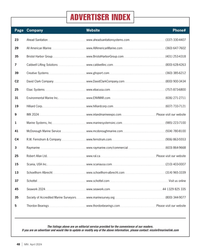 )
April 2024 - Marine News page: 48
)
April 2024 - Marine News page: 48.com (401) 253-4318 7 Caldwell Lifting Solutions www.caldwellinc.com (800) 628-4263 39 Creative Systems www.ghsport.com (360) 385-6212 C2 David Clark Company www.DavidClarkCompany.com (800) 900-3434 25 Ebac Systems www.ebacusa.com (757) 873-6800 31 Environmental Marine Inc. www.ENVMAR
-
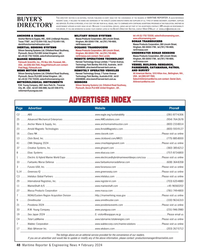 )
February 2024 - Maritime Reporter and Engineering News page: 48
)
February 2024 - Maritime Reporter and Engineering News page: 48Corporation, 280 Lincoln Street, SONAR TRANSDUCERS Texas 77087 , tel:(713) 644-1183, fax:(713) 644-1185, Hingham, MA 02043-1796 , tel:(781) 749-4800, [email protected] [email protected] Massa Products Corporation, 280 Lincoln Street, Hingham, MA 02043-1796 , tel:(781) 749-4800, INERTIAL SENSING
-
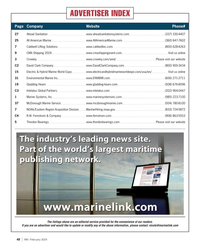 )
February 2024 - Marine News page: 48
)
February 2024 - Marine News page: 48.com (800) 628-4263 9 CMA Shipping 2024 www.cmashippingevent.com Visit us online 3 Crowley www.crowley.com/wind Please visit our website C2 David Clark Company www.DavidClarkCompany.com (800) 900-3434 15 Electric & Hybrid Marine World Expo www.electricandhybridmarineworldexpo.com/usa/en/
-
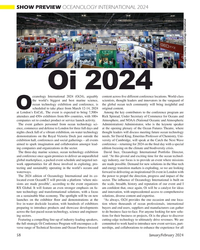 )
January 2024 - Marine Technology Reporter page: 58
)
January 2024 - Marine Technology Reporter page: 58, on-water technology thought leaders will discuss meeting future ocean technology demonstrations on the Royal Victoria Dock just outside the needs. Sir David King, Emeritus Professor of Chemistry, Uni- exhibition hall, conferences and social gatherings – all events versity of Cambridge, will speak at the
-
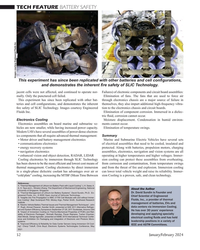 )
January 2024 - Marine Technology Reporter page: 52
)
January 2024 - Marine Technology Reporter page: 52.H. Sawa, A. A. O. Taya and L. Winston Zhang; The Department of Mechanical Engineering, National About the Author University of Singapore, Singapore Dr. David Sundin is Founder and 2. “Thermal Management of Lithium-Ion Battery Systems”, David Sundin, Ph.D. En- gineered Fluids, Inc.; © IEEE Open Journal
-
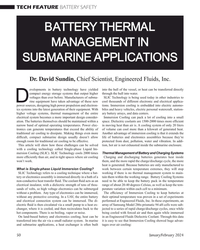 )
January 2024 - Marine Technology Reporter page: 50
)
January 2024 - Marine Technology Reporter page: 50TECH FEATURE BATTERY SAFETY BATTERY THERMAL MANAGEMENT IN SUBMARINE APPLICATIONS Dr. David Sundin, Chief Scientist, Engineered Fluids, Inc. evelopments in battery technology have yielded into the hull of the vessel, or heat can be transferred directly compact energy storage systems that output higher
-
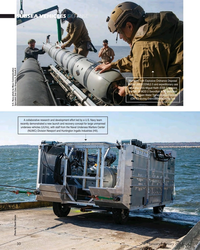 )
January 2024 - Marine Technology Reporter page: 30
)
January 2024 - Marine Technology Reporter page: 30undersea vehicles (UUVs), with staff from the Naval Undersea Warfare Center (NUWC) Division Newport and Huntington Ingalls Industries (HII). Photo By David Stoehr Specialist 2nd Class Gregory A. Pickett II 30 January/February 2024 MTR #1 (18-33).indd 30 1/31/2024 8:46:34 A
-
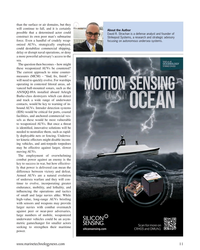 )
January 2024 - Marine Technology Reporter page: 11
)
January 2024 - Marine Technology Reporter page: 11than the surface or air domains, but they will continue to fall, and it is certainly About the Author possible that a determined actor could David R. Strachan is a defense analyst and founder of construct its own poor man’s submarine Strikepod Systems, a research and strategic advisory force. Even a
-
 )
January 2024 - Marine Technology Reporter page: 8
)
January 2024 - Marine Technology Reporter page: 8INSIGHTS SUBSEA DEFENSE SILENT, MOBILE, DEADLY: THE RISE OF COMBAT AUVS Copyright Jesper/AdobeStock By David Strachan, Senior Analyst, Strikepod Systems rone warfare has come into its own. The war in targeted by warship point defense systems and helicopter gun- Ukraine, what many analysts are calling
-
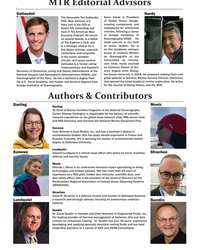 )
January 2024 - Marine Technology Reporter page: 6
)
January 2024 - Marine Technology Reporter page: 6? cer. She is the president of the board of directors for the Northeastern Regional Association of Coastal Ocean Observing Systems (NERACOOS). Strachan David R. Strachan is a defense analyst and founder of Strikepod Systems, a research and strategic advisory focusing on autonomous undersea Lundquist Sundin syst
-
 )
January 2024 - Marine Technology Reporter page: 4
)
January 2024 - Marine Technology Reporter page: 4, essentially a small, uncrewed Celia Konowe Edward Lundquist military submarine that is designed to stay at sea for up to six months at time to complete David Strachan as many missions that can be loaded into its considerable payload bay. In fact, “The sky’s the limit in terms of payloads that can be brought
-
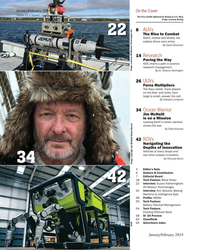 )
January 2024 - Marine Technology Reporter page: 2
)
January 2024 - Marine Technology Reporter page: 2XLUUV delivered by Boeing to U.S. Navy Image courtesy Boeing 8 AUVs 22 The Rise to Combat Silent, mobile and deadly, the subsea drone wars arrive. By David Strachan 14 Research Paving the Way NOC charts a path in science research management. By Dr. Eleanor Darlington 26 UUVs Force Multipliers
-
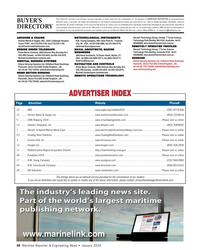 )
January 2024 - Maritime Reporter and Engineering News page: 48
)
January 2024 - Maritime Reporter and Engineering News page: 48429498089, [email protected] Texas 77087 , tel:(713) 644-1183, fax:(713) 644-1185, City, MI , USA , tel:231-946-3980, fax:231-946-4772, [email protected] [email protected] REMOTELY OPERATED VEHICLES ENGINE ORDER TELEGRAPH NAVAL ARCHITECTS, MARINE Harvest Technology Group
-
 )
November 2023 - Marine Technology Reporter page: 14
)
November 2023 - Marine Technology Reporter page: 14well as the broader opera- Timing (PNT) attacks (e.g. GPS spoo? ng), which can result tional and strategic challenges they will present. About the Author David R. Strachan is a defense analyst and founder of Strikepod Systems, a research and strategic advisory focusing on autonomous undersea systems. 14
-
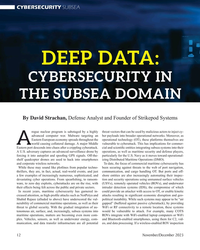 )
November 2023 - Marine Technology Reporter page: 12
)
November 2023 - Marine Technology Reporter page: 12CYBERSECURITY SUBSEA DEEP DATA: CYBERSECURITY IN THE SUBSEA DOMAIN By David Strachan, Defense Analyst and Founder of Strikepod Systems rogue nuclear program is sabotaged by a highly threat vectors that can be used by malicious actors to inject cy- advanced computer worm. Malware targeting an ber payloads
-
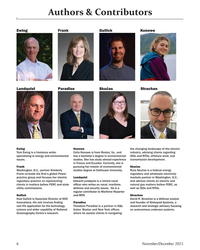 )
November 2023 - Marine Technology Reporter page: 6
)
November 2023 - Marine Technology Reporter page: 6issues. He is a well as ISOs and RTOs. regular contributor to Maritime Reporter Gullick and MTR. Strachan Huw Gullick is Associate Director at NOC David R. Strachan is a defense analyst Innovations. His role involves ? nding Paradise and founder of Strikepod Systems, a real life application for
-
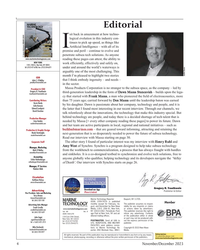 )
November 2023 - Marine Technology Reporter page: 4
)
November 2023 - Marine Technology Reporter page: 4technology and people, and it is Celia Konowe Edward Lundquist the latter that I found most interesting in our recent interview. Through our channels, we David Strachan talk relentlessly about the innovations, the technology that make this industry special. But behind technology are people, and today there
